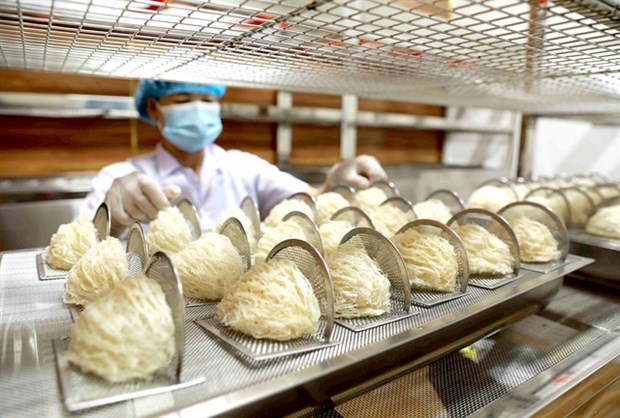Vietnam bird's nests to enter Chinese market through official channel
Vietnam bird’s nests will be officially exported to China after the protocol on allowing the exportation of this product was signed by both countries.
 Refined bird's nest products produced in a farming site in Ha Tinh province. China opens its market for Vietnam's bird's nest. (Photo: VNA)
Refined bird's nest products produced in a farming site in Ha Tinh province. China opens its market for Vietnam's bird's nest. (Photo: VNA) Minister of Agriculture and Rural Development Le Minh Hoan on November 16 signed this protocol after it was signed by China’s side.
Hoan said the ministry will start preparing the promotion strategy to export bird's nests to China soon.
China is the world's largest market for bird's nests, accounting for more than 80% of the global market share. According to the specialised data on bird's nest imports, demand for this product has risen steadily in this market with the import volume rising from 180 tonnes in 2019 to 220 tonnes in 2020 and more than 300 tonnes in 2021.
Meanwhile, Vietnam has many favourable conditions for swiftlet farming with its long coastline, many islands, bays and lagoons. The quality of Vietnam bird's nest products is also considered superior to other countries in the region and favoured by Chinese consumers.
At the same time, Vietnam has a long border with China which is very convenient for trading and transporting goods to the Chinese market, creating a more competitive advantage for Vietnamese products.
Given its economic value and export potential, since 2019 the Ministry of Agriculture and Rural Development (MARD) has negotiated and submitted to the General Department of Customs of China for the official export of this product to China.
“After three years of tenacity, we signed the protocol, starting the official export of bird’s nest products to China. I think after unlocking this market, our bird’s nest industry will be restructured and create higher added value, generate more income for swiftlet farmers and processing enterprises,” Hoan said.
Immediately after signing the protocol, MARD requested relevant units and agencies to fully inform industry associations, bird’s nest farming sites and farmers about regulations on traceability and food safety according to the protocol.
The ministry also requested bird’s nest processing enterprises study and fully comply with the requirements of the Chinese side on the management of swiftlet-raising establishments and processing to ensure disease control, food safety and traceability.
Associations and businesses need to closely coordinate with specialised agencies and localities to urgently develop and organise a surveillance programme for bird flu and Newcastle disease on swiftlets, and a food safety monitoring plan for bird's nest products.
“In the long term, the ministry will have a strategy and plan to develop the Vietnamese bird's nest industry responsibly and sustainably, preserving the Vietnamese bird's nest brand and meeting the requirements of China, as well as other potential markets,” Hoan said.
According to the Department of Livestock Production (MARD), in the past five years, swiftlet farming has developed strongly in 42 provinces and cities nationwide, concentrating in the South-Central region and the Central Highlands.
Currently, more than 22,000 swiftlet houses have been installed nationwide with an annual output of about 120 tonnes worth over 500 million USD.
So far, 13 agricultural products of Vietnam have been allowed to be exported to the Chinese market, including dragon fruit, rambutan, longan, mangosteen, mango, jackfruit, lychee, watermelon, durian, and banana among others./.












